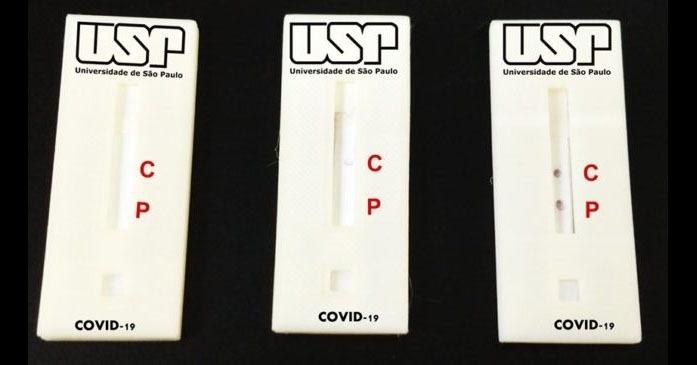Technology based on nanoparticles identifies IgG antibodies and costs only about a fifth of similar devices now on the market. It was developed by scientists at the University of São Paulo and Brazilian startup Biolinker.

Credit: Karla Castro/USP
A test that detects antibodies to the novel coronavirus in 10 minutes and costs only a fifth of the market average has been developed by researchers at the University of São Paulo’s São Carlos Chemistry Institute (IQSC-USP) and Brazilian startup Biolinker, with São Paulo Research Foundation – FAPESP’s support.
The device works similarly to the rapid tests available now in pharmacies. It analyzes a drop of blood, and two red LEDs light up if it detects the presence of immunoglobulin G (IgG) antibodies, which are produced in the acute phase of COVID-19 (ten days after the onset of symptoms on average).
“The more antibodies there are in the blood, the brighter the red color. We believe this means the test can also be used to monitor the response to vaccination. We know not everyone develops protective immunity after being vaccinated. We also know the level of antibodies declines over time,” Frank Crespilho, a professor at IQSC-USP and principal investigator for the study, told.
The study was conducted by two of Crespilho’s students, Karla Castro and Isabela Mattioli. According to Crespilho, the technology can easily be adapted to the novel SARS-CoV-2 variants, if necessary.
The test can be sold for 30 Brazilian Reais (now about 5.50 US dollars) once it has been approved by ANVISA, the national health surveillance authority, he said. Similar tests can currently be purchased in Brazil for about 140 BRL. The researchers optimized the quantity of raw materials and reagents to lower its production cost and developed a technology based on nanoparticles to facilitate IgG detection.
“We combined a gold nanoparticle [which originates the red color] with a piece of the virus’s spike protein recognized by human antibodies. This bioconjugate is about a millionth of the size of a human hair,” Crespilho said.
The virus’s spikes form the corona-like structure that suggested its family name. They enable the virus to enter and infect human cells by binding to the ACE-2 receptor on the cell surface.
To develop the molecule used in the test device, Biolinker’s researchers worked in the laboratory to synthesize the docking tip of the spike protein, known as the receptor-binding domain (RBD). According to Mona Oliveira, Biolinker’s chief science officer and co-founder, they used a recombinant DNA technology involving bacteria genetically modified to express the viral protein in vitro. This part of the process was supported by São Paulo Research Foundatin – FAPESP’s Innovative Research in Small Business Program (PIPE) and FINEP, the Brazilian Innovation Agency.
“All reagents and other inputs used by the device are produced in Brazil, which helps reduce the cost. We worked around the clock to develop it in just four months,” said Crespilho, who heads the University of São Paulo’s Bioelectrochemistry and Interface Laboratory.
The aim is to expand testing in Brazil by making it affordable for low-income families. “We designed it as a means of enabling mass testing at a competitive cost in line with economic reality,” he said.
Testing is underway to determine the accuracy of the method developed by the IQSC-USP group. The scientists are also working on a plan to ramp up production and have other groups perform trials to validate the methodology. Around 500 units will be produced and tested using samples from patients treated at São Paulo State University (UNESP) in Botucatu, the Federal University of São Carlos (UFSCar) and the Federal University of São Paulo (UNIFESP).
“We’re also negotiating with groups in the Northeast region,” Crespilho said. “Validation will take about a month. Then we’ll apply for approval by ANVISA.”
###
Crespilho is supported by FAPESP via several projects (19/15333-1, 19/12053-8, 18/11071-0 and 18/22214-6), by the National Council for Scientific and Technological Development (CNPq) and by the Ministry of Education’s Coordination for the Improvement of Higher Education Personnel (CAPES).
About São Paulo Research Foundation (FAPESP)
The São Paulo Research Foundation (FAPESP) is a public institution with the mission of supporting scientific research in all fields of knowledge by awarding scholarships, fellowships and grants to investigators linked with higher education and research institutions in the State of São Paulo, Brazil. FAPESP is aware that the very best research can only be done by working with the best researchers internationally. Therefore, it has established partnerships with funding agencies, higher education, private companies, and research organizations in other countries known for the quality of their research and has been encouraging scientists funded by its grants to further develop their international collaboration. You can learn more about FAPESP at http://www.
Media Contact
heloisa reinert
[email protected]
Original Source
https:/




